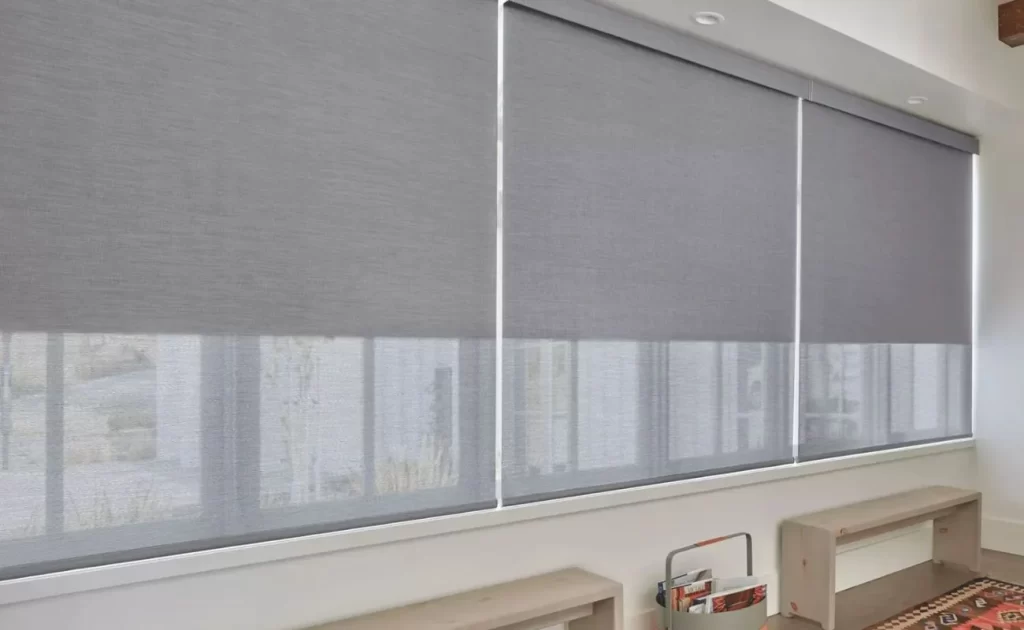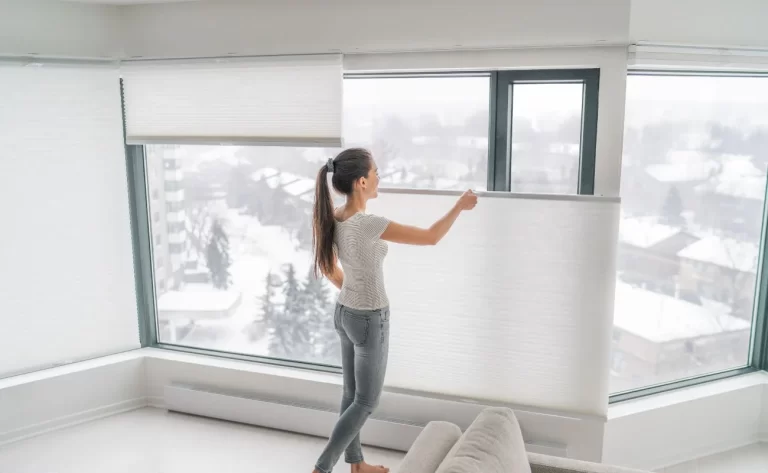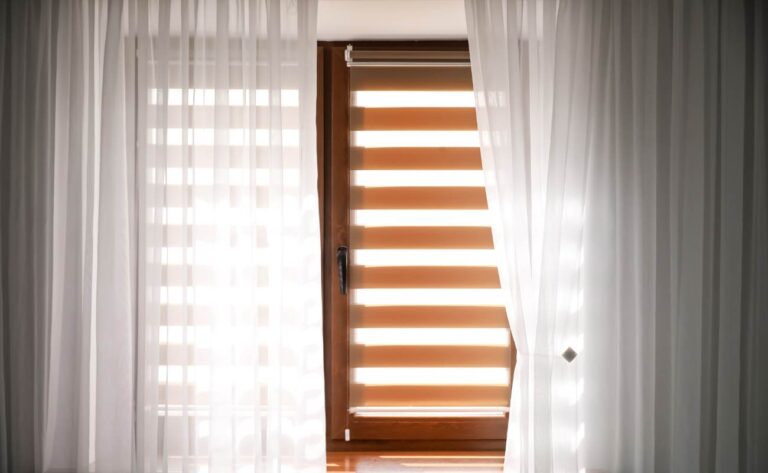Table of Contents

If you’ve been asking yourself, “What are solar shades, and why are they suddenly so popular?” then you’ve come to the right place. Solar shades are increasingly becoming a must-have window treatment, and you might be surprised at just how much they can transform your living space. From their sleek appearance to their practicality in blocking harmful rays and reducing glare, solar shades could be exactly the solution you’ve been searching for.
UNDERSTANDING WHAT SOLAR SHADES ARE
At their core, solar shades are window coverings made with a specialized fabric designed to filter out sunlight. When you compare solar shades to standard blinds or curtains, the main difference is that these shades are engineered to reduce heat and glare while still preserving some of your view. In other words, you don’t have to choose between natural light and sun protection—you can have both.
HOW SOLAR SHADES WORK
You may wonder how a simple fabric can deliver so many benefits. The answer lies in the weave. Solar shade fabrics are tightly woven to control the amount of sunlight entering the room. This construction allows you to block a significant percentage of the sun’s rays, including ultraviolet (UV) light, without plunging you into complete darkness. By filtering out harsh sunlight, solar shades keep your space cooler and more comfortable, all while helping to protect your furniture and flooring from fading.
KEY BENEFITS OF CHOOSING SOLAR SHADES
- Glare Reduction: If you’ve ever tried to watch television or work on a computer with blinding sunlight hitting the screen, you know how frustrating glare can be. Solar shades cut back on that glare, improving your comfort and making screen viewing far more pleasant.
- UV Ray Protection: Overexposure to the sun’s UV rays can damage your skin, fade upholstery, and discolor hardwood floors. Solar shades offer a protective shield, filtering out many of these harmful rays.
- Energy Efficiency: By preventing excess heat from entering your home, solar shades help regulate indoor temperatures. That means you could see a reduction in your energy bills since your cooling system doesn’t have to work as hard.
- Preserved Views: Unlike blackout curtains or heavy drapes, solar shades let you maintain a connection to the outdoors. You’ll get the benefit of natural light and an outside view while still enjoying privacy during the day, depending on your chosen openness factor.
- Sleek Aesthetic: If you’re aiming for a modern, minimalistic vibe, solar shades can instantly elevate the look of your space. Their clean lines and subtle presence complement almost any décor.
UNDERSTANDING THE “OPENNESS FACTOR”
One unique aspect of solar shades is something called the “openness factor.” This term refers to the tightness of the fabric weave, which directly affects how much light passes through:
- Low Openness (1%-5%): Offers maximum light control and superior UV protection. Ideal if you prioritize blocking heat and protecting interiors from fading.
- Medium Openness (5%-10%): Strikes a balance between moderate heat and glare control, while still allowing a decent view of the outside.
- High Openness (10%-14%): Lets in more natural light and offers a clearer outdoor view, but provides less heat and UV protection.
When choosing your shades, think about whether you’d prefer a brighter space with a better view or maximum heat and glare reduction.
SOLAR SHADES VS. OTHER WINDOW TREATMENTS
- Solar Shades vs. Roller Shades: Standard roller shades often serve a similar function but are usually made from opaque fabrics. Solar shades focus on filtering sunlight and reducing glare without blocking your view.
- Solar Shades vs. Drapes: Drapes add elegance, but they can block too much light and are often heavy. Solar shades are typically lightweight, easy to clean, and more flexible in controlling glare.
- Solar Shades vs. Blinds: Traditional blinds can be adjusted for varying sunlight levels, but they might not address glare as effectively. Solar shades create a consistent shield against harsh sunlight.
FACTORS TO CONSIDER BEFORE BUYING
- Privacy Needs: Solar shades are most effective for daytime privacy. At night, especially with indoor lights on, they won’t provide the same coverage. You can pair them with drapes or consider a dual shade system.
- Interior Décor: Fabric colors and textures matter. Lighter colors reflect more heat, while darker fabrics may reduce glare more effectively. Consider how each option aligns with your overall décor.
- Budget: Costs vary based on fabric type, brand, and motorized features. Decide if you want a simple pull-down shade or a high-tech motorized system.
- Maintenance: Though they don’t gather dust like traditional blinds, solar shades still need occasional cleaning with a soft brush or cloth to keep them looking fresh.
INSTALLATION AND SETUP
Installing solar shades is often straightforward. Most come with hardware for inside- or outside-mount configurations. After measuring carefully, secure the brackets and attach the shade’s headrail. If you’re not comfortable with DIY, hiring a professional ensures a perfect fit.
KEEPING YOUR SHADES IN TOP CONDITION
- Dust or Vacuum: Use a soft brush attachment or a microfiber cloth to remove dust.
- Spot Clean with Mild Soap: Gently remove stubborn stains with mild soap and water. Allow the fabric to dry completely before rolling the shade back up.
- Inspect Hardware: Periodically check brackets and moving parts to ensure everything remains secure and functional.
CUSTOMIZING YOUR SOLAR SHADES
Beyond selecting an openness factor, you can choose different headrail styles (exposed roller or covered with a valance), opt for decorative hems, and even go with motorization. Motorized shades let you adjust light levels at the touch of a button—a smart choice if your windows are high or you value convenience.
MAKING THE MOST OF YOUR SPACE
Consider placing solar shades where they’ll have the biggest impact:
- Living Room: Reduce screen glare while enjoying natural light.
- Home Office: Cut down on computer screen glare for a more comfortable working environment.
- Sunroom or Enclosed Patio: Strong sunlight can make these areas too hot. Solar shades keep them inviting by reducing heat and glare.
WHY SOLAR SHADES ARE POPULAR AMONG HOMEOWNERS
You’ve probably noticed more people incorporating solar shades into their homes, and it’s easy to see why. They strike a near-perfect balance between style, function, and sustainability. By helping you rely less on air conditioning, solar shades can contribute to lower energy costs, all while preventing furniture and flooring from fading. Their subtle design also blends seamlessly with various interior styles, from minimalist to traditional.
ADDRESSING COMMON CONCERNS
- Nighttime Privacy: A single solar shade might not provide full privacy after dark. Layering with curtains or using dual shades is a simple fix.
- Cost: Solar shades can be pricier than basic blinds, but their energy-saving benefits and protection for your interior can offset the initial investment.
- Durability: Quality solar shade fabrics are built to withstand frequent use. You can raise and lower them multiple times a day without significant wear and tear.
FINAL THOUGHTS ON SOLAR SHADES
So, what are solar shades in the grand scheme of home improvement? They’re an investment in comfort, style, and practicality. By filtering the sun’s rays, you’ll enjoy a cooler interior, protect your furniture, reduce glare, and still maintain an airy, open feel in your home. When you weigh the pros and cons, remember that this is a window treatment that works for you all day long—helping you save on energy costs and making life at home more enjoyable.
If you’re ready to transform your space and reap the benefits of solar shades, now is the perfect time to take the leap. By making this change, you’re choosing a more comfortable, stylish, and energy-efficient home environment you’ll appreciate for years to come.



